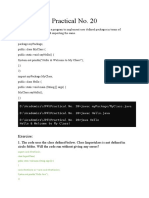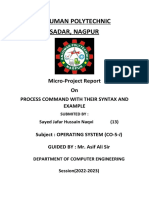0%(1)0% found this document useful (1 vote)
180 viewsSoftware Testing (STE 22514) UNIT TEST 1 Questions From MSBTE Exams
Software Testing (STE 22514) UNIT TEST 1 Questions From MSBTE Exams
Uploaded by
Krishna AhireThis document contains 34 questions related to software testing from an MSBTE examination. The questions cover key topics in software testing including defining software testing and its objectives, different types of testing (static, dynamic, black box, white box), quality assurance and quality control, verification and validation, defects and their causes, test case specification, bugs, errors, faults, failures, V-model, skills for software testers, code coverage analysis, and the differences between techniques like inspection vs walkthroughs, and drivers vs stubs.
Copyright:
© All Rights Reserved
Available Formats
Download as PDF, TXT or read online from Scribd
Software Testing (STE 22514) UNIT TEST 1 Questions From MSBTE Exams
Software Testing (STE 22514) UNIT TEST 1 Questions From MSBTE Exams
Uploaded by
Krishna Ahire0%(1)0% found this document useful (1 vote)
180 views2 pagesThis document contains 34 questions related to software testing from an MSBTE examination. The questions cover key topics in software testing including defining software testing and its objectives, different types of testing (static, dynamic, black box, white box), quality assurance and quality control, verification and validation, defects and their causes, test case specification, bugs, errors, faults, failures, V-model, skills for software testers, code coverage analysis, and the differences between techniques like inspection vs walkthroughs, and drivers vs stubs.
Original Title
Software Testing (STE 22514) UNIT TEST 1 Questions from MSBTE Exams
Copyright
© © All Rights Reserved
Available Formats
PDF, TXT or read online from Scribd
Share this document
Did you find this document useful?
Is this content inappropriate?
This document contains 34 questions related to software testing from an MSBTE examination. The questions cover key topics in software testing including defining software testing and its objectives, different types of testing (static, dynamic, black box, white box), quality assurance and quality control, verification and validation, defects and their causes, test case specification, bugs, errors, faults, failures, V-model, skills for software testers, code coverage analysis, and the differences between techniques like inspection vs walkthroughs, and drivers vs stubs.
Copyright:
© All Rights Reserved
Available Formats
Download as PDF, TXT or read online from Scribd
Download as pdf or txt
0%(1)0% found this document useful (1 vote)
180 views2 pagesSoftware Testing (STE 22514) UNIT TEST 1 Questions From MSBTE Exams
Software Testing (STE 22514) UNIT TEST 1 Questions From MSBTE Exams
Uploaded by
Krishna AhireThis document contains 34 questions related to software testing from an MSBTE examination. The questions cover key topics in software testing including defining software testing and its objectives, different types of testing (static, dynamic, black box, white box), quality assurance and quality control, verification and validation, defects and their causes, test case specification, bugs, errors, faults, failures, V-model, skills for software testers, code coverage analysis, and the differences between techniques like inspection vs walkthroughs, and drivers vs stubs.
Copyright:
© All Rights Reserved
Available Formats
Download as PDF, TXT or read online from Scribd
Download as pdf or txt
You are on page 1of 2
Software Testing (STE – 22518)
Questions from MSBTE Examination
1. Define software testing and role of testing.
2. What is Software testing? Give any three objectives of testing.
3. Enlist objectives of software testing.
4. What are the objectives of software testing?
5. Enlist different types of test deliverables.
6. Explain test case specification
7. What is bug? Why do bug occurs?
8. Define Defect.
9. Define following terms –
i) Error ii) Fault iii) Bug iv) Failure
10. What are different causes of software defects?
11. Explain verification and validation with neat diagram.
12. Explain Quality assurance and quality control.
13. Explain static and dynamic testing.
14. Explain black box and white box testing.
15. Explain white box testing as technical review.
16. Define verification and validation with respect to software testing.
17. Define static and dynamic testing.
18. Differentiate between Quality Assurance and Quality Control.
19. Differentiate between black box and white box testing.
20. Differentiate between drivers and stub (any four points)
21. State the different errors found in static testing.
22. State the different errors found in dynamic testing.
23. Enlist errors that are uncovered during black box testing.
24. Enlist errors that are uncovered during white box testing.
25. Enlist and describe any four skills for software tester.
26. Explain V-model with labeled diagram.
27. State any two advantages and disadvantages of ‘V’ model.
28. State classification of white box testing
29. Write short notes on : (i) Inspection (ii) Structured walkthroughs
30. Explain the difference between walkthrough and inspection.
31. Explain any one type of structural white box testing in detail.
32. Describe Unit Testing.
33. Explain the concept of stub and driver.
34. Explain various code coverage in detail. How it is used in analyzing
coding of software?
You might also like
- MicroprojectDocument18 pagesMicroprojectDilip ShivdikarNo ratings yet
- ACN (22520) - UT-2 Question BankDocument1 pageACN (22520) - UT-2 Question Bankprathameshspatil2004pNo ratings yet
- CH 4 Test ManagementDocument50 pagesCH 4 Test ManagementShrimant H. NikamNo ratings yet
- Css Practical 15Document3 pagesCss Practical 15Shekhar JadhavNo ratings yet
- Advanced Java Practical 12Document7 pagesAdvanced Java Practical 1203 - Mayuresh GaikwadNo ratings yet
- OSY 09ptttcDocument10 pagesOSY 09ptttcpremnoob96No ratings yet
- STE ProjectDocument35 pagesSTE Projectabhisawant3101No ratings yet
- Practical No. 23, 24 & 25Document2 pagesPractical No. 23, 24 & 25Shreyash “SKYxSHREYASH” KadamNo ratings yet
- Osy Solved Manual Diploma WorldDocument161 pagesOsy Solved Manual Diploma World1213Varsharani KasliwalNo ratings yet
- Unit 1 AjpDocument65 pagesUnit 1 Ajpmanojschavan6No ratings yet
- Online Feedback System: A Micro Project Report ONDocument16 pagesOnline Feedback System: A Micro Project Report ONchaitanyakurandale1No ratings yet
- Online Voting Management System Project ReportDocument110 pagesOnline Voting Management System Project ReportLEARNING LABS CONSULTINGNo ratings yet
- 2023 Summer Question Paper (Msbte Study Resources)Document4 pages2023 Summer Question Paper (Msbte Study Resources)shraddhaj2903No ratings yet
- 22518-2023-Winter-Question-Paper (Msbte Study Resources)Document2 pages22518-2023-Winter-Question-Paper (Msbte Study Resources)theboyaman22No ratings yet
- Osy NotesDocument13 pagesOsy Notespankaj waghmareNo ratings yet
- Dma NotesDocument69 pagesDma Notessejal PolNo ratings yet
- Ajp MCQ Chapter 5Document54 pagesAjp MCQ Chapter 5st5617067No ratings yet
- Oop Winter 2019 (C++)Document21 pagesOop Winter 2019 (C++)Aditya BorleNo ratings yet
- STE Microproject Report On Mobile ApplicationDocument12 pagesSTE Microproject Report On Mobile ApplicationDadasaheb PatareNo ratings yet
- Mobile Application Development - For PrintingDocument122 pagesMobile Application Development - For PrintinghahaNo ratings yet
- Use of Cardlayout To Write A Two-Level Card Deck That Operating SystemDocument10 pagesUse of Cardlayout To Write A Two-Level Card Deck That Operating SystemSamreen ChowlkarNo ratings yet
- Practical No 24 Gad 22034 1Document3 pagesPractical No 24 Gad 22034 1shindeshivanjali1525No ratings yet
- STE Pra 14Document1 pageSTE Pra 14gmpawar003No ratings yet
- Aim: Write A Program To Demonstrate The Use of AWT Components. X. Program CodeDocument9 pagesAim: Write A Program To Demonstrate The Use of AWT Components. X. Program CodeSiddhi SawantNo ratings yet
- Client Side Scripting Language (22519) Semester - V (CM) : A Laboratory Manual ForDocument21 pagesClient Side Scripting Language (22519) Semester - V (CM) : A Laboratory Manual ForSY CHAUBAL YATISH SHASHIKANTNo ratings yet
- Zeal Polytechnic: Micro ProjectDocument14 pagesZeal Polytechnic: Micro ProjectAbhishek ShelarNo ratings yet
- Sample-Question-Paper - Computer NetworkDocument4 pagesSample-Question-Paper - Computer Network14SYCMIIIShruti DawangeNo ratings yet
- CPP Project For Tyco StudentsDocument12 pagesCPP Project For Tyco StudentsAditya YadavNo ratings yet
- STE (Final) MicroprojectDocument14 pagesSTE (Final) MicroprojectRupesh BavgeNo ratings yet
- OSY Summer 23Document25 pagesOSY Summer 23706:Pranav BhingareNo ratings yet
- OSY MicroprojectDocument10 pagesOSY MicroprojectIF19Pratik ShingadeNo ratings yet
- Osy Question Bank Unit 3 To 6 (22516)Document6 pagesOsy Question Bank Unit 3 To 6 (22516)Tanmay ChikhaleNo ratings yet
- Practical No. 20Document4 pagesPractical No. 20Shreyash “SKYxSHREYASH” KadamNo ratings yet
- CSS Pract 11-16 - MergedDocument31 pagesCSS Pract 11-16 - Mergedrathodharshalr1905No ratings yet
- Program-1.2 //develop A Program To Select Multiple Languages Known To User (Eg. Marathi, Hindi, English, Sanskrit)Document2 pagesProgram-1.2 //develop A Program To Select Multiple Languages Known To User (Eg. Marathi, Hindi, English, Sanskrit)rohitchavan2345No ratings yet
- Department of Computer EngineeringDocument17 pagesDepartment of Computer EngineeringVivek MhaisdhuneNo ratings yet
- Title: - Develop Javascript To Use Decision Making and Looping StatementsDocument8 pagesTitle: - Develop Javascript To Use Decision Making and Looping StatementsSoham ParabNo ratings yet
- MSBTE Sample Question Paper: Remember Level 1MDocument35 pagesMSBTE Sample Question Paper: Remember Level 1MEeeeewwNo ratings yet
- Model Answer: Important Instructions To ExaminersDocument33 pagesModel Answer: Important Instructions To ExaminersPratiksha KatapNo ratings yet
- Dsu ReportDocument9 pagesDsu ReportHarshal PatilNo ratings yet
- PDFDocument5 pagesPDFTAJKAZINo ratings yet
- AJP Practicals: Practical 1Document37 pagesAJP Practicals: Practical 1YashNo ratings yet
- Practical No.13Document7 pagesPractical No.13Pratiksha JadhavNo ratings yet
- Staff Leave Management System ReportDocument35 pagesStaff Leave Management System ReportUmair KhanNo ratings yet
- CPP Project Final 23-24Document16 pagesCPP Project Final 23-24gaurisahu4567No ratings yet
- Css Practical 7 and 8Document13 pagesCss Practical 7 and 8Shekhar JadhavNo ratings yet
- Acn Unit 5Document33 pagesAcn Unit 5Naidu ThamminainaNo ratings yet
- Design and Create Web Page of An Institute (22519)Document36 pagesDesign and Create Web Page of An Institute (22519)Tanishka PatilNo ratings yet
- Css Practical 12 & 13Document6 pagesCss Practical 12 & 13Aashish KhobragadeNo ratings yet
- Practical No.2 Develop Javascript To Use Decision Making and Looping StatementsDocument8 pagesPractical No.2 Develop Javascript To Use Decision Making and Looping StatementsIF-Sanket borasteNo ratings yet
- Quiz AjpDocument32 pagesQuiz Ajpsoham.mate21No ratings yet
- Css Practical 13Document3 pagesCss Practical 13Shekhar JadhavNo ratings yet
- Java Practical No.10 PDFDocument7 pagesJava Practical No.10 PDFMeer KukrejaNo ratings yet
- Index: Sr. No. Page No. Annexure I - Micro Project Proposal 1-2Document11 pagesIndex: Sr. No. Page No. Annexure I - Micro Project Proposal 1-2Avadhut DeshmukhNo ratings yet
- OSY Report 13Document11 pagesOSY Report 13Evan BoseNo ratings yet
- 5&6 Sem Question PaperDocument81 pages5&6 Sem Question PaperTanishka PatilNo ratings yet
- Ede Practical No 13 FinalDocument5 pagesEde Practical No 13 FinalDev PathakNo ratings yet
- Software Testing & Quality AssuranceDocument3 pagesSoftware Testing & Quality Assurancek20pro9t4No ratings yet
- Software Testing Question BankDocument3 pagesSoftware Testing Question Bankkalpakpatil2004No ratings yet
- STE Question Bank For Unit Test #1Document2 pagesSTE Question Bank For Unit Test #1Nikita PatilNo ratings yet



























































